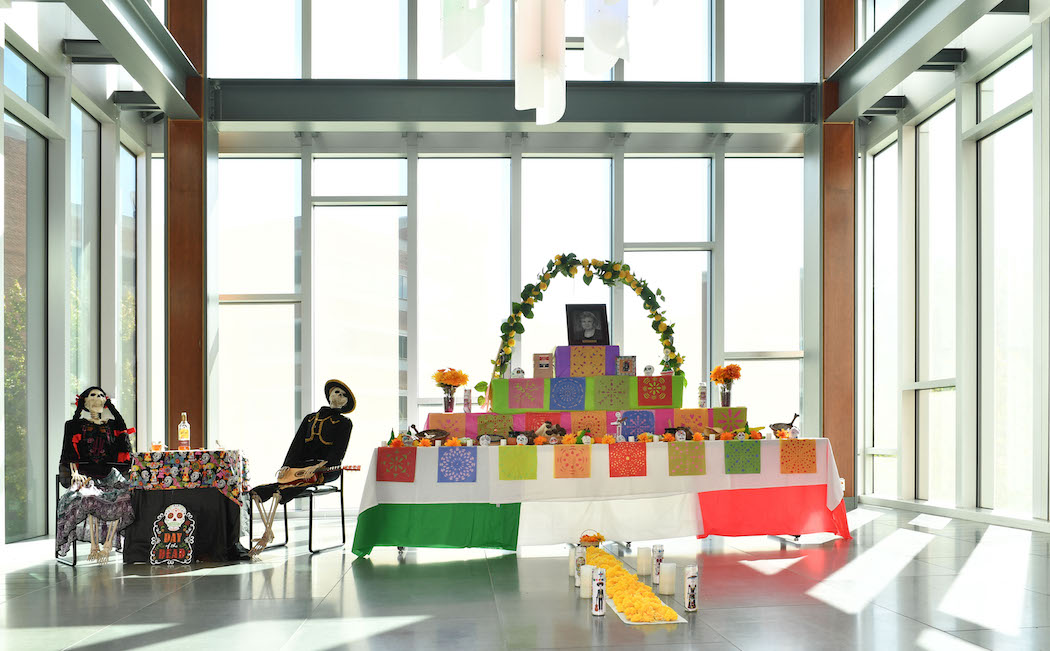TU professor: Nothing spooky or sad about Día de Los Muertos
Get insight into the days that help people confront their mortality and remember their loved ones
By Bethany Pace on October 31, 2022

Coming on the heels of Halloween, it may be common for major retailers and general
observers to see Día de Los Muertos (Day of the Dead) as an extension of Halloween.
In actuality, however, sweet treats—specifically in the form of skulls made of sugar
and decorated with brightly colored icing (called calaveras de azucar)—are likely
the only connection between Halloween and Day of the Dead. Despite the prominent imagery
of skulls, Día de Los Muertos isn’t meant to be spooky at all.
According to Lea Ramsdell, professor emerita of Spanish and Portuguese in the Department of Languages, Literatures and Cultures the holiday is “a time to remember the dead, but it’s also a time to realize your mortality and not be afraid of it.”
Read more: Figurines from Mexico watch over Lea Ramsdell’s office
Ramsdell, who has “more of a personal interest” in Día de Los Muertos as opposed to a scholarly interest on the topic, shares five things about the evolution and true meaning of Día de Los Muertos:
Día de Los Muertos has a stronger connection to Catholicism than it does to Halloween.
“The holiday evolved from the Catholic holidays of All Saints Day (Nov. 1), a day to honor saints and children who have died, and All Souls Day (Nov. 2), a day to honor all the adults who have passed away. Day of the Dead is a manifestation the Aztec and Indigenous influences of central Mexico coming together with Catholicism to create something different.”
Death isn’t always sad, and Día de Los Muertos is a time to see death differently.
“Remembering the people who have passed away is a very important part of the holiday. It is not solemn, though. It is a celebration. Día de Los Muertos is more about healing than it is about feeling bad. Celebrating Day of the Dead means facing the fact that death is real and that although our loved ones are no longer with us, we can remember them and are happy that their spirits have returned to be with us during the holiday.”
In the 20th century, activists and artists have embraced Día de Los Muertos for political, cultural and social commentary.
“There was a dictatorship for almost 40 years in Mexico that eventually ended in the Mexican Revolution. During this period José Guadalupe Posada, a journalist and graphic designer, started to really popularize the skeleton imagery for Day of the Dead. Posada really used the image and related folk art as a way of social commentary on the dictatorship and upper classes who believed that they were better than the masses. Posada’s point was to remind those with greater social status that they are mortal after all.”
Portraying the dictator as a skeleton was a way of saying, ‘You are going to die too, we are all going to die. We don’t care who you are or how much power you have, in the end you are mortal.’ So on Day of the Dead, we really see [in the artwork and symbols] these images of everyone’s mortality.”
The commercialization of Día de Los Muertos in popular culture or in stores isn’t all bad.
“[The 2017 film] Coco really got people interested in Day of the Dead in a way that they had not been before. The cultural references in the movie were actually researched for the film so the bright orange cempoalxochitl (pronounced cem-pa-SU-chil) used to form a trail from the loved one’s tomb back home and the ofrenda [altar] depicted in the film are pretty close to what you might see in Mexico and the borderlands (Arizona, California, New Mexico, and Texas) where Day of the Dead is big.”
Day of the Dead is a holiday that anyone can celebrate, regardless of cultural heritage. Ideally, it should remind us of our commonalities as humans.
“I don’t think it would be considered cultural appropriation if someone wanted to make an ofrenda in their house to honor their ancestors. I do it because my parents are gone now, and my grandparents. I put my altar up for about a week and it is a reminder and understanding how my loved ones are still a part of me.”
Celebrate Día de Los Muertos in Baltimore
Cielo Presents: Día de los Muertos
Nov. 5, 2022, 12–4 p.m.
Patterson Park & Creative Alliance (3134 Eastern Avenue, Baltimore)
Meet at Patterson Park at noon for a procession to the Creative Alliance, then enjoy dance performances, live music, a costume contest, art making and more.
Day of the Dead Community Celebration
Nov. 1, 2022, 6–9 p.m.
The Peale Museum (225 Holliday Street, Baltimore)
The National Museum of the American Latino presents an ofrenda and procession to honor
and support the healing of the community of Uvalde, Texas. The muralist and altarist
Frida Larios has been commissioned to create the ofrenda and a mural honoring those
killed in the mass shooting at Rob Elementary School.